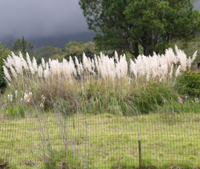
pampas grassCortaderia jubata, Cortaderia selloana (Poaceae) Pampas grass is a large bunchgrass from South America. The leaves are narrow and have sharp, serrated edges, and the showy white to purple flower plumes are sometimes used in floral arrangements. Both species of pampas grass are considered serious pests in California and New Zealand, where they outcompete native species and create a fire hazard. Both species of pampas grass were planted as ornamentals in upcountry Maui, and Cortaderia jubata has spread to other yards, pastures, and native forests. Cortaderia jubata plants are able to produce viable seeds without pollination, and seeds are spread primarily by wind. It is considered very invasive and is on the Hawaii state noxious weed list The invasive nature of Cortaderia selloana was historically sometimes not recognized in Hawaii because only female plants were cultivated and sold. This species generally requires cross-pollination between male and female plants to produce viable seeds. The introduction and spread of male Cortaderia selloana plants has caused an explosion of this species in California and New Zealand, and Maui is ripe for a similar situation.
For more information about pampas grass and MISC's efforts to control it, check out MISC's Fall 2006 Kiai Na Moku O Maui Nui newsletter |

pampas grass (Cortaderia sp.)
More information on pampas grass: |
|
|
Some documents posted on the HEAR website are in Adobe Acrobat PDF format. If your computer is not already set up to read these files, you can download the FREE Adobe Acrobat reader. You can set up most web browsers to automatically invoke this reader (as a "helper application" or "add-in") upon encountering documents of this type (refer to your browser's documentation for how to do this). |
|
| The Hawaiian Ecosystems at Risk (HEAR) project is currently funded by the Pacific Basin Information Node (PBIN) of the National Biological Information Infrastructure (NBII) through PIERC (USGS) with support from HCSU (UH-Hilo). More details are available online. |
|
| This page was created on 24 March 2003 by EMS, and was last updated on 06 Febuary 2007 by LF. The source material for the content of this page was provided to HEAR by MISC. |
|